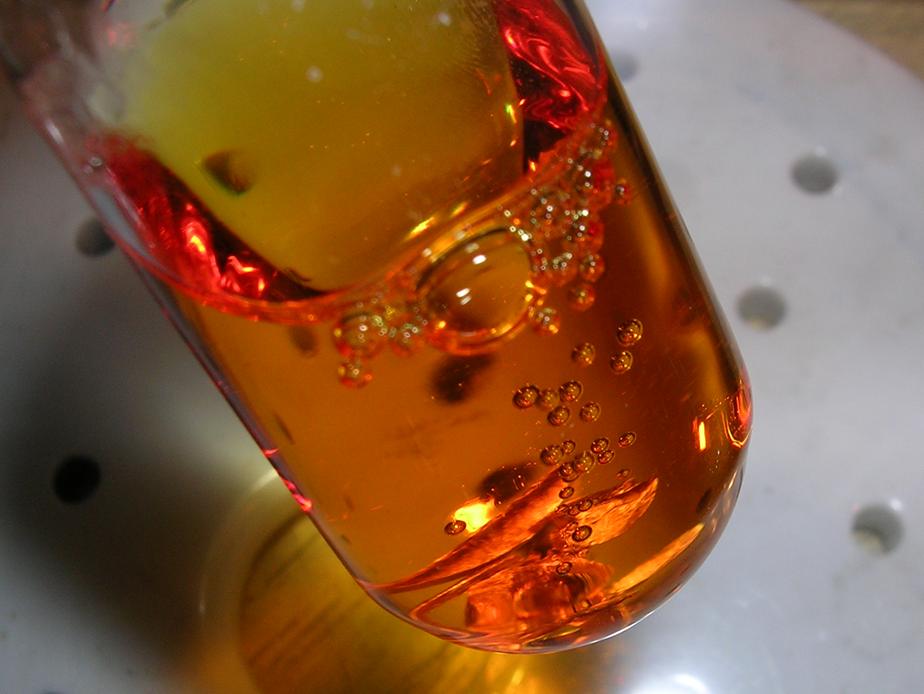
Alchemy has been an interest of mine for quite awhile…to me it represented the more glamorous and legacy aspect of chemistry. So it was with interest as I was preparing this week’s article that aqua regia, “royal water” played a part. Back in my chemistry days, I worked in a precious metals refinery which meant that gold was one of the products we worked with, including the refining of it. Aqua regia was a staple in my daily work life and often because it was so corrosive minute amounts of the gold solution (made up of aqua regia & gold) or chloroauric acid would leak through my gloves and get on my hands. As this was in the 70’s I would just wash my hands and go on with my day. However after a few months at this job my husband and I went to Aruba — as soon as the tropical sun hit my hands they turned black and purple from the silver nitrate and gold chloride respectively. Don’t be horrified, it was the 70’s and it made me think that my hands were more valuable!
meant that gold was one of the products we worked with, including the refining of it. Aqua regia was a staple in my daily work life and often because it was so corrosive minute amounts of the gold solution (made up of aqua regia & gold) or chloroauric acid would leak through my gloves and get on my hands. As this was in the 70’s I would just wash my hands and go on with my day. However after a few months at this job my husband and I went to Aruba — as soon as the tropical sun hit my hands they turned black and purple from the silver nitrate and gold chloride respectively. Don’t be horrified, it was the 70’s and it made me think that my hands were more valuable!
Dissolving the Nobel Prize: How Science Defeated the Nazis
The history books are full of tales of great capers and feats of derring-do, but some of the most breathtaking are quite compact in scale. Such is the story of the physicist Niels Bohr and chemist Gyorgy de Hevesy saving the (literally) prized possessions of two Bohr’s colleagues from plunder — with science!
In 1940, Bohr was running his Institute of Theoretical Physics in Copenhagen, where de Hevesy worked in the lab. The Nazi forces that were sweeping Europe had finally taken Denmark, and Bohr had a unique problem: he was hiding contraband gold that fellow physicists Max von Laue and James Franck had smuggled out to him from Germany for safekeeping — in the form of their respective medals for the 1914 and 1925 Nobel Prize in Physics.
Harbouring this secret gold was a capital offense under the new regime. Bohr had to hide the medals, fast; and in an ingenious way, as the dogged Nazis, who now had much practice in pillaging, would be sure to find the medals if they were buried in the garden, as de Hevesy first suggested.
As a chemist extraordinaire, de Hevesy turned to his trade for his next try. He found the solution in (wait for it…) a solution:
“He took the first [medal], he says, and ‘I decided to dissolve it. While the invading forces marched in the streets of Copenhagen, I was busy dissolving Laue’s and also James Franck’s medals.’
[… G]old is a very stable element, doesn’t tarnish, doesn’t mix, and doesn’t dissolve in anything — except for one particular chemical emulsifier, called ‘aqua regia,’ a mixture of three parts hydrochloric acid and one part nitric acid.”
De Hevesy spent a nail-biting afternoon slowly dissolving both medals into the aqua regia. What resulted was an unremarkable beaker full of a reddish brown liquid, which escaped the Nazis’ notice when they finally arrived and ransacked the lab.
The beaker was so non-descript that, once Bohr and de Hevesy returned from exile after the war ended, it still sat on the shelf on which they had left it. And then de Hevesy worked a wonderful bit of science magic: he reversed the original reaction and extracted the gold back out of the solution, then sent it off to the Royal Swedish Academy of the Sciences. Von Laue’s and Franck’s medals were recast, and presented back to them in a ceremony in 1952! (De Hevesy racked up his own Nobel in 1943, for “ his work on the use of isotopes as tracers in the study of chemical processes.”)